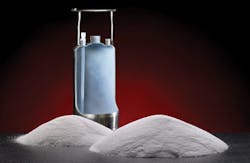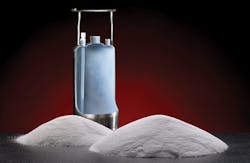By Katie Sprick and Bob Parker
Corrosion is the number-one enemy of industrial tanks and vessels, and the damage is costly on many levels. Not only does it destroy tank components, it also can contaminate the stored product, release the contained materials into the environment, raise safety concerns and increase operating costs.
The goal, then, is to defend against corrosion. The ROI from reduced maintenance, limited recoating and extended vessel life typically offsets any upfront cost to defend against corrosion.
So, the question becomes: which exterior coatings and interior linings are the best in terms of longevity, durability and cost effectiveness?
From the inside out
Exterior corrosion often jumps out as a first concern for the simple reason that it is easily seen on the outside of the vessel. However, interior corrosion is just as much a threat, and neglecting to protect against it can reduce storage tank productivity. Moreover, the best exterior coating solution might not be the best lining for inside the tank.
Interior corrosion control must focus on selecting a suitable lining based on the material being stored, because different substances react in their own unique way with tank interiors. Vessel linings must resist chemicals attack, heat and abrasion, as well as a proven, successful field-performance history.
The vessel’s exterior, on the other hand, faces regular assaults of heat, cold, ultraviolet rays and wind-blown particles, leading to corrosion of unprotected surfaces. Therefore, it is necessary to apply a coating that provides superior corrosion resistance and adhesion to ensure the tank’s long-term performance.
Advantages inherent
When used in corrosive chemical environments, ETFE linings allow for less expensive vessel substrates, such as carbon steel, saving upfront fabrication costs. These linings may also be replaced or repaired while reusing the original piece of equipment.
ETFE is a melt-processable copolymer of tetrafluoroethylene and ethylene. It possesses outstanding physical toughness and high resistance to heat, chemical attack and aging. The powder is ideal for seamless rotational linings (rotolinings) and electrostatic coatings for industrial tanks. These tanks are used in chemical-processing applications in the food, petroleum and potable water and wastewater industries.
ETFE can be applied as an electrostatic coating up to thicknesses of 0.060". Electrostatic coatings are installed by applying a charge to the powder and using a spray gun to apply coverage to all vessel interior surfaces. The vessel is then baked in an oven to cure the coating, and this is repeated four or five times to build a seamless coating. This is a cost-effective way to add a thick-film, corrosion-resistant barrier to any shaped object. For additional protection, one lining coat can be electrostatically applied at the same time to the exterior of the vessel for protection against chemical drips and environmental concerns.
For exceptionally harsh processes, an even thicker lining can be installed using rotolining. The process involves adding the powder into the tank and spinning it while heating.
Conforming, free-flowing powder
Rotolining vessels is superior to traditional sheet-lining methods because the free-flowing powder naturally conforms to interiors and does not typically require welding and sealing. This process may result in a lining of up to 0.250" thick. The lack of seams eliminates stress-risers that can prematurely cause a sheet-lining failure, as well as minimizes areas that can accumulate dirt, keeping the process cleaner and allowing easier clean-up of the vessel interior. Traditional bonded and loose-sheet linings are restricted to use in very simple shapes and geometries and require numerous seams, regardless of the vessel design. In addition, loose-sheet linings can collapse under vacuum.
Fisher Co. of North Salt Lake, Utah, uses ETFE exclusively in complicated vessel-lining projects. One of Fisher’s more challenging projects was lining thirteen deionized water mixed and polishing beds for a leading semiconductor foundry. Three of the vessels were the largest in the world to have interior coatings. Challenges included the tanks’ ten-foot diameter and more than 100 holes in a perforated interior plate. Fisher Co. clearly saw that traditional sheet lining or other fluoropolymer coatings could not successfully handle the project intricacies.
UV rays, wind, rain etc.
When considering corrosion resistance for tank exteriors, fluoroethylene vinyl ether (FEVE) resins, which are formulated into paints, protective coatings and sealants, we believe deliver performance superior to conventional resin chemistries.
Although traditional fluoropolymer PVDF-based coatings deliver excellent characteristics that improve weathering and corrosion resistance, they are limited in formulation and application. Pure PVDF has poor solubility in solvents and must be blended with other polymers in order to be formulated into a liquid coating. Also, most PVDF-based coatings require heat to cure, which limits application to the factory setting.
We believe FEVE resins deliver superior durability, color retention, gloss retention and reduced maintenance costs, as well as excellent resistance to corrosion, dirt, UV rays, wind, rain, chemicals and petroleum products. Comprised of alternating segments of fluoroethylene and vinyl ether, the resins are synthesized with reactive hydroxyl groups and can be cross-linked with standard aliphatic isocyanates to make fluorourethane coatings that offer extreme strength.
Another advantage of FEVE resins is ease of application. Exterior coatings can be applied at room temperature, which preserves the integrity of the interior lining. Unlike traditional fluoropolymer-based products that must be applied in the factory because they need to be heated to 200 C to form a film, the resins don’t require heating. They can be applied in the field as well as factory.
The resins are transparent, provide outstanding adhesion to primers, fiberglass, plastics, composites and metals, including aluminum and steel, and can be used in both clear and pigmented coatings.
What to look for
When considering these resins for industrial tank-coating applications, look for solvent-based and water-based polymers, including solid-flake resins, which allow the formulation of coatings with no or low volatile organic compounds (VOC) and no hazardous air pollutants (HAP).
Although standard polyurethane-based coatings are less expensive on initial purchase, we believe that over the life of the tank these formulations don’t deliver long-term protection like coatings using fluoropolymers or FEVE resins. When lifecycle costs are taken into account, we believe the FEVE coating system offers a 45-percent cost advantage after 10 years and a 26-percent cost advantage after 18 years over standard polyurethane coatings.
Fabricator Tnemec Co., Inc., of Kansas City, Missouri, used FEVE resin technology to recoat the exterior of a 500,000-gallon steel-substrate water tank in the Village of Rosemont, Illinois, which is said to resemble a gigantic bouquet of long-stemmed roses. The rose pattern required six different colors, which had to be applied in two different layers. The finish coat was chosen for its versatile application properties, superior long-term gloss, color retention, life expectancy, superior coverage rates and exceptional UV protection, giving it the ability to withstand the degrading effects of sunlight, according to Tnemec coating consulting Erik Otten.
Beyond Tanks and Vessels
In coating industrial tanks and vessels, the weatherability and corrosion resistance of FEVE resins make them attractive for inclusion in topcoats for steel and concrete surfaces. Further ETFE applications include rotational lined chemical process components for fluid handling such as valves, pumps, pipes, fittings and other complex parts.
Storage tanks and vessels are valuable assets in the processing industry, protecting products and materials at various stages of the operation. Maintaining these investments, inside and out, can produce long-term, cost-effective results.
Katie Sprick is a product and development engineer and Bob Parker is a chemist with AGC Chemicals Americas, Inc., which manufactures, markets and sells high-quality fluoroproducts and specialty chemicals. Headquartered in Exton, Pennsylvania, AGC Chemicals Americas maintains manufacturing operations in nearby Thorndale, and warehouses throughout North America. For more information call 800-424-7833.



